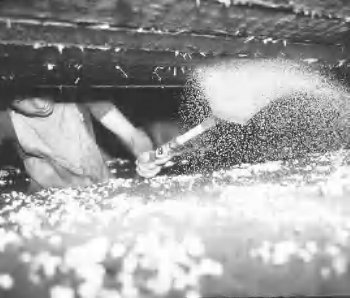Watering or Irrigation
The moisture content of the casing often determines the uniformity of the casing depth. Casing, both by equipment and by hand, becomes more difficult as the casing material increases in moisture (Figure 15). Peat moss casing will lump up or adhere to the different parts of the equipment, making the flow of the material uneven.

Figure 15. Most watering is done by hand, although newer farms use hand-propelled watering trees.
Knowing when, how, and how much water to apply to casing is an art form that readily separates experienced growers from beginners. Watering the crop is the most delicate operation in mushroom growing. Although each grower may have his or her own preference, no specific casing-management practice and casing material are universally accepted. Despite so much diversity, many growers are still able to harvest good crops with good freshmarket quality. Although much has been written about when and how much water to apply at certain stages in the crop’s development, most growers rely on their ability to »read» the crop and determine how the mushrooms look from day to day. Water constantly moves throughout the cropping period: water is lost through evaporation and transpiration, and the mushroom takes up water into its cells; water is replaced when watering the casing layer. The increase in the weight of the mushroom from pinning to maturing is related to the rapid uptake of water from the casing and compost. The mushroom doubles in size 2 days before harvest, putting more strain on the pipe system in the compost and casing. As the mushroom matures during a flush, its weight gain is attributed to the accumulation of nutrients and water from the substrate.
4588 view.